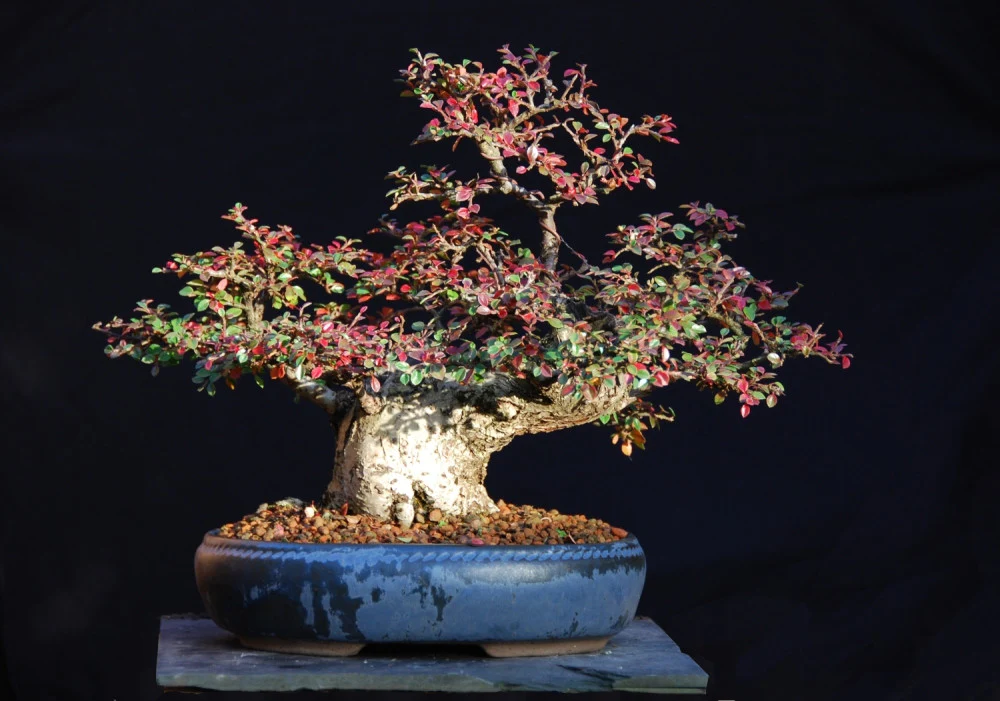On this page, you’ll find handy hints and tips from Way of Life Bonsai for caring for Cotoneaster Bonsai.
Don’t forget to check out our tools and essential items, access advice and guidance from our experts, and check out our other specimen, beginner and Outlet trees.

Caring for Cotoneaster Bonsai: Cotoneasters prefer to be placed in the sun during growing season, but they should be placed in partial shade when its strong heat on summer days. When frosty they will need to be protected.
Caring for your Cotoneaster Bonsai: The Cotoneaster requires a lot of water in the summer & growing season, During the cold winter months the roots should be kept slightly moist and overwatering can cause root rot.
Caring for Cotoneaster Bonsai: Feed the Cotoneaster every week with liquid fertiliser or apply a solid organic fertiliser every four weeks during the growing season. Use a balanced product with sufficient phosphorous, potassium and micronutrients to promote flowers and fruit.
Caring for Cotoneaster Bonsai: Cotoneasters take constant pruning to a very high standard. Older branches are best pruned in spring. Young shoots need to be regularly trimmed during the growing season.
Caring for your Cotoneaster Bonsai: Young trees can be repotted once a year where as, older cotoneasters only need to be repotted every two or three years. Use a well-draining standard soil mix. Cotoneasters can tolerate a wide range of pH values between acidic and alkaline.
Caring for Cotoneaster Bonsai: Cotoneasters grow easily from seed in spring or from cuttings in mid-summer.
Caring for your Cotoneaster Bonsai: Cotoneasters can be bothered by aphids, scale, caterpillars, borers, spider mites, fire blight, bacterial blight, powdery mildew and diverse leaf spot and root rot fungal diseases.
In some regions, fire blight is a huge problem. Cotoneaster horizontalis and some cultivars of Cotoneaster microphyllus seem to be less prone to fire blight. If pests or diseases occur, use a specific pesticide or ask a professional gardener for help in severe cases.
Cotoneaster Trees: A Versatile and Ornamental Delight in Your Garden
Cotoneaster trees, members of the Rosaceae family, are a diverse and enchanting addition to any garden. These deciduous or evergreen shrubs and small trees are known for their adaptability, ornamental appeal, and the myriad of ecological benefits they bring to your outdoor space.
1. Aesthetic Charm:
Cotoneasters are prized for their aesthetic appeal. With their lustrous green foliage, delicate white or pink flowers, and vibrant red berries, they add a touch of elegance to any landscape. The foliage often takes on vibrant autumnal hues, providing a captivating display of reds and oranges, making them a visual delight throughout the seasons.
2. Landscape Versatility:
One of the key attractions of cotoneaster trees lies in their versatility. Whether you’re looking for a ground cover, a hedge, or a standalone ornamental tree, there’s a cotoneaster variety to suit your landscaping needs. Their adaptable nature allows them to thrive in various soil types and conditions, making them a favorite among both novice and experienced gardeners.
3. Wildlife Friendly:
Cotoneasters are not just a treat for the eyes; they also contribute to the overall health of your garden ecosystem. The berries produced by these trees are a valuable food source for birds, especially during the colder months. Their presence can attract a variety of bird species, adding a lively and natural element to your garden.
4. Easy Maintenance:
For those seeking low-maintenance greenery, cotoneaster trees fit the bill. These hardy trees are relatively disease-resistant and can withstand a range of growing conditions. Once established, they require minimal care, making them an excellent choice for busy gardeners or those new to horticulture.
5. Erosion Control:
Certain cotoneaster species, particularly those with trailing or prostrate growth habits, serve as effective ground covers. Planted on slopes or hillsides, they act as a natural erosion control measure. Their dense foliage helps stabilise soil, preventing erosion and adding a touch of greenery to areas that might otherwise be challenging to landscape.
6. Bonsai Potential:
For enthusiasts of the ancient art of bonsai, cotoneaster trees present an exciting canvas. Their small leaves, graceful branches, and adaptability make them well-suited for bonsai cultivation. With proper care and pruning, cotoneaster bonsai can be a captivating addition to your collection, offering the charm of a full-sized tree in miniature form.
In conclusion, cotoneaster trees stand as versatile, visually appealing, and ecologically beneficial choices for your garden. Whether you seek a pop of color, a haven for wildlife, or an easy-to-maintain greenery, cotoneasters offer a delightful and practical solution for enhancing the beauty of your outdoor space. Consider introducing these charming trees to your garden and watch as they flourish, bringing year-round beauty and ecological vitality.
Web Design | Terms | Privacy